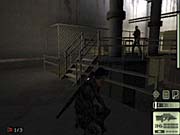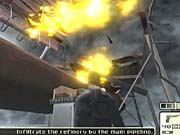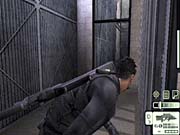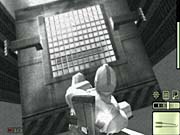Splinter Cell PS2 Designer Diary
Producer Domitille Doat talks about the technical achievement, new content, and environment design in the upcoming PlayStation 2 version of Ubi Soft's award-winning stealth action game.
Designer Diary 04/03/02
By Domitille DoatProducer, Ubi Soft Shanghai
Technical Achievement
When Tom Clancy's Splinter Cell was originally released for the Xbox, it was hailed as a graphical coup, and the industry credited it with inspiring people to rethink the treatment of lighting and shadows in video games. The dynamic lighting effects were more than just a shiny package; they figured prominently in the gameplay, becoming a central character in the game. The critical acclaim left people wondering if it was even possible to bring this game to the PS2, a system perceived to be less technologically advanced than the Xbox. Expectations were high, and everybody was eager to see how we would approach the translation to the PS2. It was certainly a lot of pressure for our Shanghai team.

In order to create an environment rich with shadow, we had to design a dynamic lighting system based on a strong engine. We chose to work with the Unreal engine for the PlayStation 2 because it offered the power and flexibility we needed. If possible, we wanted to offer the player even more interaction with lights and shadows than was possible in the Xbox game, and we believed that the Unreal engine could make that possible.
We started the production one year ago by prototyping an entire mission on the PS2. It took us three months to really have a perfect prototype capable of delivering the high-quality graphics that we were aiming for. Once we learned that our engine could support our vision, the next step was designing all the details.
Our development mantra was always that it would be the final result that counted. Reaching that final result would require creativity and knowledge. When selecting algorithms, we looked into all possible solutions for any given problem, whether scientifically precise or rough simulations. Sometimes, a mixture of solutions had to be used to balance the graphics quality and the demands placed on the engine--specifically in frame rate and memory. After solutions were implemented, the parameters were fine-tuned with the help of graphic designers to reach the best result onscreen. Finally, each feature was allocated a certain CPU or GPU time, as well as a limit of memory usage. The engineers were responsible for optimizing the code to satisfy all these restrictions. The main features of course are the whole light and shadow system--key effects for the soul of the gameplay. With the implementation of the light map, dynamic lights, and projected shadows, we were able to create an atmosphere on the PS2 that was true to the essence of the game. The lighting of the character changes gradually depending on the light position in combination with the visibility indicator.

To further refine the effects we employed a 2D expert who specializes in trompe l'oeil--tricks of the eye--to hand-create sophisticated textures that reinforce the realism so important to the Clancy brand. When combined with the lighting, the entire effect was better than we could ever have imagined.
When viewed next to the Xbox version, I can proudly say that both games look very similar--which anyone who has programmed for either platform would agree is an achievement. But our team went beyond creating an identical twin for the new platform; we implemented new effects that create a really sophisticated and tight visual identity. In the PS2 game, there are real-time reflections on surfaces and a hazy heat effect that radiates out from hot spots--these effects are not included in the Xbox game.
Critics have told us that Tom Clancy's Splinter Cell is one of the best-looking games out for the PS2, and we think that gamers will agree. When they see how good this game looks they are going to freak out!
The New Content
It was important for us to give each platform something unique. Tom Clancy's Splinter Cell for the PS2 features an exclusive full-length powerplant level available only to PS2 players. In the powerplant level, Sam will come face-to-face with mercenary technicians who have access to the information he needs. Because the area is crowded with civilian workers doing their 9-to-5 jobs, the situation is complicated. Sam must be careful that no innocents are harmed. It's one of the toughest parts of the game.
Also, new for the PS2 is Sam's stealth snowsuit that lets him disappear into his surroundings during a frigid Russian snowstorm. He also has a great new gadget--zooming binoculars that come in very handy throughout Sam's ordeal.

The new level is nicely integrated into the storyline and makes sense within the plot. It's not just an "extra mission," but a more revealing and deeper story. That's not a coincidence. Conveniently, it was a concept that was first slated for the original version of the game--the Xbox version--but because of the tight development schedule, it ended up on the cutting-room floor.
Environment Design
The development team is particularly proud of Splinter Cell's open-ended gameplay.
Playing this game is a unique experience. You have maximum freedom. You aren't led down a linear path but instead are encouraged to experiment with strategies. There is no right way to do anything--it's all a matter of individual style, and we encourage you to inject it with your own special sauce.
Realistic options: It's not easy to create a game that allows so many options, because on the development side that means there are many constraints--lots and lots of rules. We have to make sure the player will be able to do anything that would be possible in real life because they will rely on their natural instincts when confronted with a new situation. This focus can be seen in the details of the game--small things like breakable lights, windows, and vases; soda cans that can be thrown; aquariums that leak water when you shoot them. But it's also visible when you look at some of the other choices a player must make. Do you go through the window or the door? Walk along the street or sneak across the roof? Jump down on an enemy and stun him or sneak by undetected? Throw an object to distract a guard or try to take a shot?

Consistency: All the levels have been designed to allow players to achieve their mission in different ways. That means that there are rules. If Sam can jump to reach a certain height, he needs to be able to reach that height throughout the game, so the levels must be designed to either allow him to reach those heights or be just out of reach so that he must find another approach.
Limitations: Every move and gadget has strengths and weaknesses in terms of reach and efficiency. The sticky shockers can reach a certain distance, as can the cameras. Sniping can reach farther, but the noise may alert another guard. So what do you want to do?
The balance of the game is based on the way the levels are designed to take these limitations into account, on where the enemies are positioned, and on the number of gadgets available. There are no right or wrong ways of doing things, but some levels encourage a stealth approach more than a guns-blazing Rambo tactic. There is almost always a way to avoid direct confrontation.
All these elements give a very realistic feel to the game and are exciting to the player because he or she has free reign. But it also adds a lot of complexity to the content creation. The solution is to base everything on realistic and coherent environments only and make them lively and full of details, and players will find their own way through, developing a personal playing style as they advance through the game.
Got a news tip or want to contact us directly? Email news@gamespot.com
Join the conversation